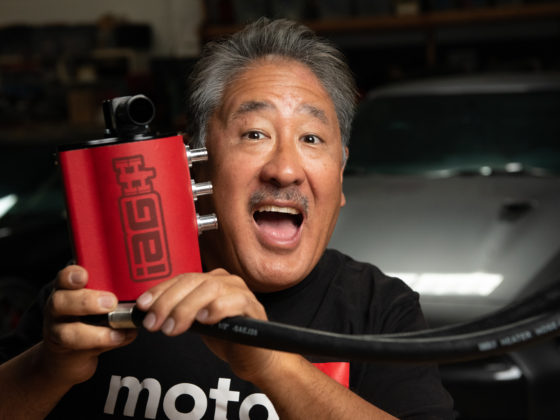After adjustments, Christa could even Manji the kart although it still was difficult to be smooth due to the instability and didn’t look so good.
The moral of the story is, if you have a high-end racing kart with typical racing kart chassis and steering geometry, these drift tire sleeves are not going to work super well without some extensive setup changes. It helps if your dad is a Formula Drift chassis engineer. If you have an el-cheapo recreational 4-stroke lawnmower engine kart, with golf cart-like steering geometry, it just might work better for this than an expensive real racing kart. We could probably do a little better on the race kart with more chassis tuning but Christa didn’t want to mess around and risk losing her race set up with an event next weekend.
Really to make this work well we would have to cut up the knuckles and change the steering geometry. We don’t want to do this to an expensive racing chassis. Does anyone want to donate a cheapo thrasher kart chassis to us so we can perfect the drift kart?
We are thinking of building an adaptor that we can bolt on the knuckles so we can move the outer tie rod in order to remove more Ackerman from the steering geometry. We think that will wake this chassis up as far as for drifting. We do have an old CRG chassis for the shop that we might try this on.
So don’t buy these and expect to be an instant drift king, there is probably more to it than that, especially if you are thinking of using a real race kart chassis. If we get around to making something work we will update this story.




9 comments
do you think putting the sleeves on the front would introduce enough slip to make it easier to manage? also, dad of the year?
No, it would be really hard to control and you would still have the basic problem of not enough steering angle and too much Ackerman angle and too much front drag.
When you say “a lot of ackerman angle”, what does that mean? More inside wheel scrub or less? I am confused… Cool article!
It means the inside wheel turns more than the outside.
Haha, nice article! Looks like a fun experiment even if it didn’t work out.
This is definitely something I’ve wanted to try one I get a kart.
Thanks for this writeup, I found it to be quite helpful. I am an amateur rally racer and I’m building an electric kart to get accessible seat time between rallies. I am very keen to turn it into a drift kart.
What you wrote at the end matched up well with my own thoughts on how I might be able to turn this into well tuned a drifting machine. I will be playing around with the steering geometry – hoping that plus the insane torque from the electric motor is able to get the job done.
Would you be willing to connect briefly on this? You seem incredibly knowledgeable on the subject, I think it would help tons. I’m more than happy to share my results with you! I don’t see a way to send you a message here. Am I missing something or is that the case? If so I will give you a burner email in here. Thanks!
a few years back my son and 10 year old son and i used to play with an old margay sprint kar (mine) and an old Rup racing kart (his). both were terrible on at street drifting, but were AMAZING on grass and dirt with Harbor freight Pred motors. The instant torque and broader power band made throttle modulation sublime and even with drift slicks the Rup was a decent drifter if the speeds were low.
Funny experience: I noticed that the jacking and Ackerman was great for grass and dirt drifting on kart slicks thanks to the lower surface friction. It allowed for CRAZY angle at high speeds and awesome feints.
That’s said I have a big diameter rear axle. I flipped the rear wheels and mounted them backwards to narrow the rear track. That alone made the Kart less likely to spin out, even on pavement.
Yeah the high strung two stroke is way less than ideal for this for sure.